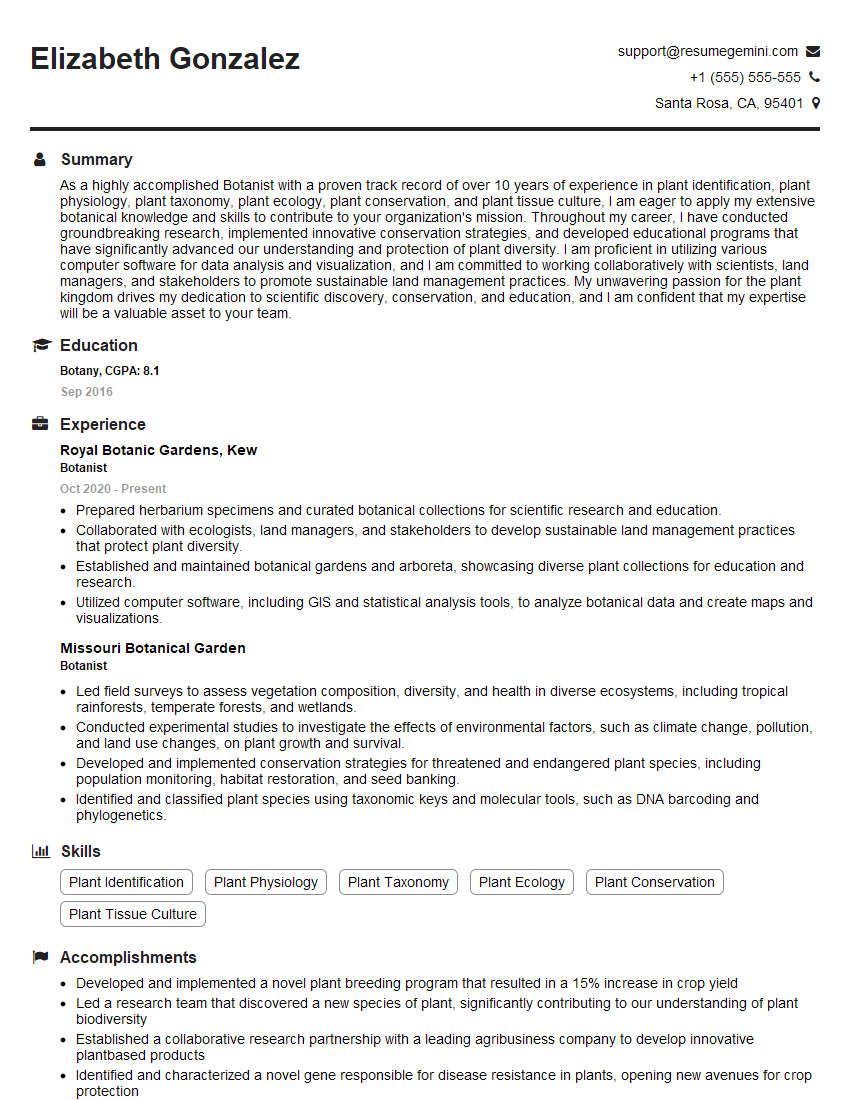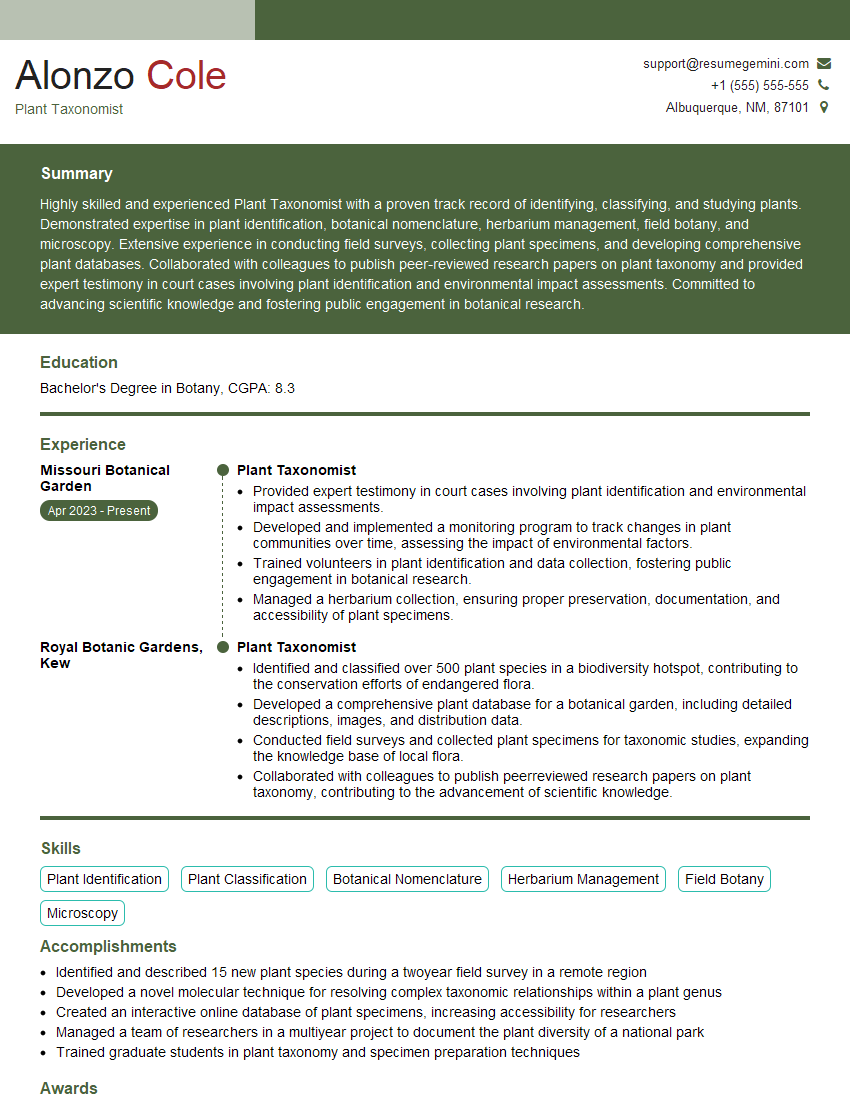Cracking a skill-specific interview, like one for Leaf Shape Identification, requires understanding the nuances of the role. In this blog, we present the questions you’re most likely to encounter, along with insights into how to answer them effectively. Let’s ensure you’re ready to make a strong impression.
Questions Asked in Leaf Shape Identification Interview
Q 1. Describe the difference between simple and compound leaves.
The difference between simple and compound leaves lies in how the leaf blade is divided. A simple leaf has a single, undivided blade, even if the blade is lobed or deeply incised. The blade is attached to the stem via a petiole (leaf stalk). Think of a maple leaf – it’s deeply lobed, but it’s still one single blade. In contrast, a compound leaf is divided into multiple leaflets, each leaflet having its own small petiolule (leaflet stalk). The entire structure, with all its leaflets, is attached to the stem via a common petiole. Imagine a rose leaf – it’s clearly composed of several smaller, independent-looking leaflets attached to a central axis.
To distinguish them, look for the axillary bud (a small bud found where the leaf attaches to the stem). A simple leaf will have only one axillary bud at the base of the petiole, whereas a compound leaf will have an axillary bud at the base of the petiole but not at the base of each leaflet.
Q 2. What are the key characteristics of palmate and pinnate venation?
Palmate venation resembles the fingers of a hand radiating outwards from a single point at the base of the leaf blade. The main veins diverge from this central point, similar to how fingers spread from the palm. A good example is a maple leaf. The veins are prominent and run directly from the petiole to the leaf margin.
Pinnate venation features a central midrib with smaller veins branching off laterally, similar to the arrangement of feathers on a quill. These lateral veins usually occur in pairs, growing opposite one another. Many trees like oak and elm show pinnate venation. The midrib functions as a highway, transporting water and nutrients throughout the leaf, while the lateral veins form a network for efficient distribution.
Q 3. Identify three common leaf margins and provide examples of plants exhibiting each.
Leaf margins, also known as leaf edges, come in a wide variety of shapes. Here are three common ones:
- Entire: A smooth, unbroken margin. Think of a Magnolia leaf. They have a completely smooth edge with no teeth or lobes.
- Toothed (serrate): The margin has small, tooth-like projections pointing forward, like the teeth of a saw. Consider a Willow leaf; its edge is sharply toothed.
- Lobed: The margin is deeply indented, forming distinct lobes or rounded projections. Oak leaves are a classic example; their various lobes help define the species.
Observing leaf margins is crucial in plant identification because these characteristics are frequently consistent within a given species, even if other features vary.
Q 4. Explain the significance of leaf shape in plant identification.
Leaf shape is incredibly significant in plant identification because it’s a highly consistent and readily observable characteristic. Different species often exhibit unique leaf shapes, making it a valuable tool for distinguishing between plants. The combination of leaf shape, venation pattern, margin type, and other features like leaf arrangement (alternate, opposite, whorled) dramatically increases the accuracy of plant identification. Professional botanists and field ecologists rely heavily on these features for species determination, along with other characteristics like flowers and fruit.
Q 5. How does leaf shape relate to plant adaptation to its environment?
Leaf shape is intricately linked to a plant’s adaptation to its environment. Think of the needle-like leaves of conifers, like pines and spruces. These reduce water loss through transpiration in cold, dry climates. Broad, flat leaves, like those of many tropical rainforest plants, maximize surface area for sunlight capture in environments where light is abundant. Similarly, leaves that are deeply lobed, like many oak leaves, can better handle strong winds by reducing wind resistance. Plants in arid environments may have succulent, water-storing leaves, further illustrating this adaptation.
Q 6. Differentiate between ovate, lanceolate, and elliptical leaf shapes.
These three leaf shapes are all elliptical, but differ in their proportions:
- Ovate: Egg-shaped, wider near the base and tapering towards the apex (tip). Imagine a chicken egg – that’s an ovate shape.
- Lanceolate: Shaped like a lance or spearhead, longer than it is wide, tapering towards both the apex and the base. Think of the leaf of a willow tree.
- Elliptical: Roughly oval-shaped, with both ends more or less equally rounded. Consider the leaf of an elm tree.
These terms are comparative and relative, meaning the difference between them is sometimes subtle, requiring careful observation and comparison.
Q 7. What are the distinguishing features of a needle-like leaf?
Needle-like leaves, characteristic of conifers like pines, firs, and spruces, have several key features:
- Reduced surface area: Their small size minimizes water loss through transpiration, particularly crucial in dry or cold climates.
- Thick, waxy cuticle: This coating further reduces water loss and protects the leaf from harsh environmental conditions.
- Sunken stomata: These pores are often recessed in the leaf surface, further decreasing water evaporation.
- Evergreen habit: Many plants with needle-like leaves are evergreen, meaning they retain their leaves throughout the year, enabling year-round photosynthesis.
These adaptations are vital for survival in challenging environments.
Q 8. Describe the different types of leaf arrangements (e.g., alternate, opposite, whorled).
Leaf arrangement, or phyllotaxy, describes how leaves are positioned on a stem. Understanding this is crucial for plant identification because it’s a consistent characteristic within a species. There are three main types:
- Alternate: One leaf per node, arranged alternately along the stem. Think of a simple, spiraling arrangement. Many trees like oaks and elms exhibit this pattern.
- Opposite: Two leaves per node, directly across from each other. Maple trees are a classic example.
- Whorled: Three or more leaves per node, arranged in a circle around the stem. This arrangement is less common but is seen in some plants like whorled milkweed.
Visualizing these arrangements helps significantly in narrowing down plant identification. For example, if you see a tree with oppositely arranged leaves, you’ve immediately eliminated a large number of possibilities.
Q 9. How can leaf texture (e.g., smooth, hairy, leathery) aid in plant identification?
Leaf texture is another vital characteristic for plant identification. It’s all about the feel of the leaf surface and can be a key distinguishing feature between closely related species. Some common textures include:
- Smooth: A glabrous (hairless) surface, often shiny or waxy. Many magnolias have smooth leaves.
- Hairy (pubescent): Covered in trichomes (hairs), which can be soft, coarse, or even prickly. Many fuzzy-leaved plants, like lamb’s ear, utilize this for protection from the sun.
- Leathery: Thick, stiff, and somewhat rigid leaves, often found in plants adapted to dry or harsh conditions. Hollies are a good example of a plant with leathery leaves.
- Rough: With noticeable bumps or ridges on the surface.
The texture, combined with other features, provides a stronger level of identification. Imagine trying to distinguish between two similar-looking shrubs. One might have smooth, waxy leaves while the other has distinctly hairy leaves, providing a decisive distinguishing factor.
Q 10. Explain the importance of using a dichotomous key for plant identification.
A dichotomous key is an invaluable tool for plant identification. It’s a structured, step-by-step approach that uses paired statements (a dichotomy) to progressively narrow down the possibilities until you arrive at the species name. Each statement presents two contrasting choices, and by selecting the appropriate one based on the plant’s characteristics, you move to the next pair of statements. Think of it as a botanical ‘choose your own adventure’ story.
The keys are generally based on observable traits like leaf shape, arrangement, texture, margin type (e.g., serrated, toothed, entire), venation patterns, and flower characteristics. Their use ensures a systematic and logical approach, minimizing errors associated with relying on intuition or incomplete information. Imagine the immense complexity of plant diversity; dichotomous keys simplify the process and increase the accuracy of identification, especially in a field setting where you may not have access to specialized technology.
Q 11. What are some common challenges in leaf shape identification?
Leaf shape identification comes with its fair share of challenges:
- Leaf Variation: Leaves on the same plant can vary in shape and size depending on their position on the stem (e.g., juvenile vs. mature leaves), environmental conditions, and age of the leaf. A single plant might showcase multiple leaf shapes.
- Leaf Damage: Insects, diseases, or environmental stress can significantly alter leaf shape and make identification challenging. A leaf damaged by herbivores might not resemble the typical representation in a field guide.
- Similar Species: Many plant species have very similar leaf shapes, requiring close observation of other characteristics for accurate identification. The subtle differences are easy to overlook.
- Incomplete Leaf Samples: Having only fragments of a leaf might make identifying the species difficult, or even impossible.
- Seasonal Changes: Many deciduous trees will shed their leaves in winter, making identification impossible until spring. Even before shedding, autumn changes in color can make distinguishing leaves very hard.
Overcoming these challenges requires careful observation, consideration of the context of the plant, and often, consultation of multiple identification resources.
Q 12. How can environmental factors affect leaf shape?
Environmental factors play a significant role in shaping leaf morphology. Plants are remarkably adaptive, and their leaves will often reflect the conditions they grow in. For example:
- Sunlight: Leaves in full sun tend to be smaller and thicker with a higher density of protective pigments to avoid excessive sunlight and water loss. Plants in shady conditions typically have larger, thinner leaves to maximize light capture.
- Water Availability: Plants in arid environments will often have smaller, thicker, or even succulent leaves to conserve water, whereas plants in wet areas may have larger, thinner leaves.
- Temperature: Temperature extremes can impact leaf shape, potentially resulting in smaller leaves in colder climates or modifications to withstand heat stress.
- Wind: Strong winds can lead to the development of smaller, tougher, or more deeply lobed leaves to reduce wind resistance.
Understanding the interaction of these environmental factors with leaf shape is crucial for accurate identification and for interpreting the evolutionary adaptations of plants to their surroundings.
Q 13. Describe the process of creating a leaf herbarium specimen.
Creating a leaf herbarium specimen involves a careful process of collecting, preserving, and mounting a sample for long-term storage and study. The process involves these steps:
- Collecting: Select healthy, representative leaves. Include information about where and when the leaf was collected (location, date, habitat).
- Pressing: Place the leaf between sheets of newspaper and absorbent paper within a plant press. This flattens and dries the leaf, preventing it from rotting or decaying.
- Drying: The pressed leaf should be left to dry for several days to several weeks, regularly changing the absorbent paper. The press should be kept in a well-ventilated area.
- Mounting: Once dried, mount the leaf onto archival-quality herbarium sheets using acid-free adhesive. This ensures long-term preservation without damaging the specimen.
- Labeling: Attach a label to the herbarium sheet containing information about the plant species (if known), location, date, habitat, collector’s name, and any additional relevant observations.
Proper preservation techniques ensure that the herbarium specimen retains its shape, color (as much as possible), and structural integrity for many years, forming a valuable record for future botanical research and education.
Q 14. How can you distinguish between deciduous and evergreen leaves?
The distinction between deciduous and evergreen leaves centers on their lifespan and retention on the plant throughout the year:
- Deciduous leaves: These leaves live for only one growing season. They change color (usually to yellow, orange, or red) in autumn and fall off the plant before winter, leaving the branches bare. This adaptation helps plants conserve water and energy during periods of cold or drought. Maples and oaks are classic examples.
- Evergreen leaves: These leaves remain on the plant for several years (often two to five years or even longer), retaining their green color year-round. Evergreen plants continuously replace their leaves throughout the year. Pine needles and Holly leaves are classic examples.
The lifespan of the leaves, along with the presence or absence of leaf abscission (shedding) in autumn, is the most significant difference.
Q 15. What are the key features of succulent leaves?
Succulent leaves are characterized by their adaptations for water storage in arid environments. Think of a cactus or a jade plant – those plump, fleshy leaves are the hallmark.
- Thickness and Fleshininess: The leaves are typically thick and fleshy due to the presence of specialized water-storage cells called parenchyma cells. This allows them to store large amounts of water during periods of rainfall.
- Reduced Surface Area: Many succulents have reduced leaf surface area to minimize water loss through transpiration. This can manifest as small, cylindrical leaves, or even modified leaves like spines (as seen in cacti).
- Thick Cuticle: A thick waxy cuticle covers the leaf surface, reducing water loss through evaporation. This waxy layer is often visible as a whitish or bluish sheen.
- Specialized Stomata: Stomata (tiny pores on the leaf surface responsible for gas exchange) are often sunken or reduced in number to further limit water loss. They might also be located in special crypts or furrows.
- CAM Photosynthesis: Many succulents utilize Crassulacean Acid Metabolism (CAM) photosynthesis, a specialized form of photosynthesis that minimizes water loss by opening stomata at night (cooler, more humid conditions) to take in carbon dioxide and closing them during the day.
These features work together to ensure the plant’s survival in harsh, dry conditions. The visual cues—thickness, reduced size, and often a waxy or glaucous (bluish-green) appearance—are key to identifying a succulent leaf.
Career Expert Tips:
- Ace those interviews! Prepare effectively by reviewing the Top 50 Most Common Interview Questions on ResumeGemini.
- Navigate your job search with confidence! Explore a wide range of Career Tips on ResumeGemini. Learn about common challenges and recommendations to overcome them.
- Craft the perfect resume! Master the Art of Resume Writing with ResumeGemini’s guide. Showcase your unique qualifications and achievements effectively.
- Don’t miss out on holiday savings! Build your dream resume with ResumeGemini’s ATS optimized templates.
Q 16. Explain the role of leaf shape in plant photosynthesis.
Leaf shape plays a crucial role in photosynthesis by directly influencing the amount of sunlight a plant can capture. The surface area, orientation, and even the texture of a leaf are all factors.
- Surface Area: Larger leaves, like those of many tropical rainforest plants, can capture more sunlight, facilitating greater photosynthetic activity. However, larger leaves also risk increased water loss.
- Orientation: The angle of a leaf to the sun affects light absorption. Leaves can be arranged to minimize self-shading (e.g., mosaic arrangement) or to maximize light capture at specific times of the day.
- Leaf Arrangement: The way leaves are arranged on a stem (phyllotaxy) influences light interception. Alternate, opposite, and whorled arrangements each optimize light capture in different ways.
- Leaf Texture: The texture of the leaf surface, especially the presence of hairs (trichomes), can influence light reflection and absorption. Hairy leaves might reflect more light than smooth leaves.
- Leaf Shape & Light Environment: In sunny environments, plants often have smaller leaves with thicker cuticles to reduce water loss. In shadier conditions, leaves are often larger and thinner to maximize light capture.
Evolution has optimized leaf shape to maximize the efficiency of photosynthesis in specific environments, highlighting the critical interplay between form and function in plant biology.
Q 17. How can leaf shape be used to identify poisonous plants?
While leaf shape alone is not a reliable indicator of poisonous plants, certain shapes can sometimes be associated with toxicity. This is not a definitive guide, and relying solely on leaf shape is dangerous!
However, some broad generalizations are:
- Three-leaf structures (e.g., Poison Ivy): While not exclusively poisonous, the characteristic three-leaflet structure of poison ivy and related plants is a widely known warning sign. Always verify with other identifying features.
- Unusual shapes or markings: Some poisonous plants might have unusual leaf shapes, colors, or markings that set them apart. For example, the deeply lobed leaves of certain members of the nightshade family can be a clue.
- Presence of thorns or prickles: While not exclusively a poisonous plant trait, many poisonous plants have thorns or prickles as a defense mechanism. Thorns can be associated with physical harm (puncture wounds), and some thorns can transfer toxins.
It’s crucial to use multiple identification methods beyond leaf shape when dealing with potentially poisonous plants. Refer to reliable field guides, plant identification apps, and/or consult with experts before handling any unfamiliar plant.
Q 18. What are the limitations of using leaf shape alone for plant identification?
Leaf shape alone is insufficient for reliable plant identification due to the significant variability within and between species, and the influence of environmental factors.
- Intraspecific Variation: Even within a single plant species, leaf shape can vary significantly due to factors like age, sun exposure, and nutrient availability. A young plant might have different shaped leaves than an older plant.
- Interspecific Similarity: Many plant species share similar leaf shapes, making it difficult to distinguish them based solely on this feature. Many plants have broadly ovate or lanceolate leaves.
- Environmental Factors: Environmental conditions such as light intensity, water availability, and nutrient levels can significantly influence leaf shape and size, leading to phenotypic plasticity.
For accurate identification, you must consider other features like leaf arrangement, venation pattern, flower structure, fruit type, bark texture, overall plant habit, and habitat. Using multiple characteristics provides much more reliable identification. Think of it like a puzzle – leaf shape is one piece, but you need all the pieces to get a complete picture.
Q 19. How can you use leaf shape to differentiate between closely related plant species?
Differentiating closely related species using leaf shape requires meticulous observation of subtle differences.
- Leaf Margin: Examine the edge of the leaf – is it smooth (entire), toothed (serrate), or lobed? Even slight variations in tooth shape or lobe depth can be distinguishing features.
- Leaf Apex: Note the shape of the leaf tip – is it pointed (acuminate), rounded (obtuse), or blunt? Minor differences can help separate species.
- Leaf Base: Observe the shape where the leaf attaches to the stem – is it heart-shaped (cordate), tapering (attenuate), or rounded? These features are frequently significant.
- Leaf Venation: Examine the pattern of veins – are they pinnate (veins branching from a central midrib), palmate (veins radiating from a central point), or parallel? The arrangement, density, and prominence of veins can be diagnostic.
- Leaf Texture and Surface: Feel the leaf’s surface – is it smooth, hairy, or waxy? The presence or absence of trichomes (leaf hairs) and the type of trichomes can be valuable identifiers.
By meticulously documenting these subtle differences and using comparative analysis with known specimens or reliable botanical keys, one can differentiate even closely related plant species.
Q 20. Describe the techniques used for microscopic examination of leaf structures.
Microscopic examination of leaf structure provides detailed insights into cellular anatomy crucial for accurate identification and analysis.
- Light Microscopy: This involves preparing thin sections of leaf tissue and staining them with dyes to highlight cellular structures such as chloroplasts, stomata, trichomes, and vascular bundles. Magnification reveals details invisible to the naked eye.
- Scanning Electron Microscopy (SEM): SEM provides high-resolution images of leaf surfaces, revealing the three-dimensional structure of trichomes, stomata, and the cuticle. This is invaluable for studying surface features important for taxonomy.
- Transmission Electron Microscopy (TEM): TEM allows for the visualization of internal cell structures at a much higher magnification than light microscopy, revealing details of organelles and cellular membranes. This is essential for investigating cellular processes and understanding leaf adaptations.
- Micrometry and Measurements: Precise measurements of cell sizes, stomatal density, and other microscopic features are obtained using calibrated eyepieces or image analysis software. These quantitative data contribute significantly to identification and comparative studies.
Microscopic techniques are indispensable for resolving intricate anatomical details that are critical for differentiating closely related plant species or for identifying specific plant types based on their microscopic structures. This is particularly relevant for forensic botany or research involving plant evolution and adaptation.
Q 21. What are some common tools and resources used for leaf identification?
Effective leaf identification relies on a combination of tools and resources:
- Hand Lenses and Microscopes: Essential for close examination of leaf features such as venation patterns, margin details, and surface texture.
- Field Guides and Floras: Books dedicated to regional plant identification provide detailed descriptions, illustrations, and keys for identifying plants based on various characteristics.
- Plant Identification Apps: Mobile apps utilizing image recognition technology can be helpful in preliminary identification, but should be cross-referenced with other resources.
- Botanical Keys: Dichotomous keys are structured guides that use a series of paired statements to progressively narrow down the possibilities until a species identification is reached.
- Herbariums and Museums: These institutions house vast collections of preserved plant specimens, providing opportunities for comparison with known specimens.
- Online Databases: Many online databases, such as those maintained by botanical gardens and universities, offer information on plant identification, distribution, and taxonomy.
Using a combination of these tools and resources allows for a comprehensive approach to leaf identification, increasing accuracy and minimizing the risk of misidentification.
Q 22. How can you accurately document and record leaf shape observations?
Accurately documenting leaf shape requires a methodical approach combining detailed descriptions with visual records. Think of it like creating a botanical fingerprint.
Detailed Descriptions: Start with the overall leaf shape – is it ovate (egg-shaped), lanceolate (lance-shaped), linear (long and narrow), etc.? Note the leaf margin (edge) – is it serrated (toothed), dentate (coarsely toothed), entire (smooth), lobed (with rounded projections), or undulate (wavy)? Describe the leaf apex (tip) and base. Mention the leaf venation pattern (arrangement of veins) – pinnate (veins branching from a central vein), palmate (veins radiating from a central point), or parallel. Record the leaf texture (smooth, rough, hairy) and color.
Visual Records: High-quality photographs are essential. Capture multiple angles, including the top, bottom, and side profiles. Use a scale (e.g., a ruler) in the photo for accurate size reference. Consider line drawings to highlight key features like venation or margin details. Digital images should be stored with metadata, including date, location, and plant species (if known).
Data Organization: Use a standardized format for recording observations, perhaps a spreadsheet or database, with columns for each characteristic. Consistent terminology is crucial. Using established botanical terms ensures clarity and comparability across observations.
For example, I might record: “Leaf shape: ovate; margin: serrate; apex: acute; base: cuneate; venation: pinnate; texture: smooth; color: dark green; length: 8 cm; width: 4 cm.” Combined with a clear photograph, this provides a comprehensive record.
Q 23. Explain the importance of proper sampling techniques when collecting leaves for identification.
Proper sampling is vital for accurate leaf shape identification and ensures representative data. Imagine trying to understand the diversity of leaves on a single tree by examining only one leaf – you’d miss a lot!
Representative Sampling: Collect leaves from multiple locations on the plant, taking into account variations due to sun exposure, age, and position on the branch. For example, gather leaves from the top, middle, and bottom of the plant.
Sufficient Sample Size: The number of leaves needed depends on the species and variability. More variation within a species requires a larger sample. A general guideline is to aim for at least 10-20 leaves.
Controlled Conditions: If comparing leaves from different plants or locations, ensure consistent environmental conditions during collection. For example, avoid collecting leaves after a heavy rainfall, which can distort the shape.
Accurate Labeling and Storage: Each sample should be clearly labeled with date, location, plant species (if known), and any other relevant information. Store the samples properly to prevent damage or decay, perhaps in a herbarium sheet or by pressing and drying them.
Inaccurate sampling can lead to misidentification or biased conclusions. Proper techniques ensure the collected data is reliable and representative of the overall leaf shape characteristics of the species.
Q 24. Describe a situation where leaf shape identification was crucial in solving a problem.
During a recent ecological survey, we encountered an invasive plant species whose identity was initially unclear. The plant’s flowers were absent, making traditional identification methods challenging. However, a careful examination of the leaf shape, particularly the distinctive serrated margin and palmate venation, allowed us to correctly identify it as Alliaria petiolata (garlic mustard). This was crucial because it informed our management strategy. Garlic mustard is highly invasive and disrupts native ecosystems; knowing its identity allowed us to implement targeted control measures to prevent its spread and protect the local biodiversity.
Q 25. What are some advanced techniques used in leaf shape analysis (e.g., image analysis)?
Advanced techniques such as image analysis are revolutionizing leaf shape analysis. These methods provide objective and quantitative data, minimizing human error and bias.
Image Processing and Segmentation: Software can isolate and enhance leaf images, removing background noise and identifying the leaf’s boundaries. This is essential for accurate measurements and shape analysis.
Shape Descriptors: Algorithms can extract quantitative measures of leaf shape, such as aspect ratio, perimeter, area, and various moment invariants that capture aspects of the shape regardless of its orientation or size. These descriptors can then be used for classification and comparison with databases.
Machine Learning: Techniques like convolutional neural networks (CNNs) are trained on large datasets of leaf images to identify and classify leaf shapes with high accuracy. These models can learn complex patterns and features of leaf shapes, even handling subtle variations. The use of CNNs is crucial for the high throughput analysis of large collections of leaves.
These advanced techniques not only improve the speed and accuracy of leaf identification but also enable studies on leaf shape variation across populations, environments, and evolutionary lineages.
Q 26. How do you stay up-to-date on the latest advancements in plant identification?
Keeping abreast of advancements in plant identification requires a multi-pronged approach.
Scientific Journals: Regularly reviewing relevant botanical journals like the American Journal of Botany and Annals of Botany keeps me informed about new research and methodologies.
Conferences and Workshops: Attending botanical conferences provides opportunities to learn about cutting-edge techniques and network with other experts.
Online Databases and Resources: I actively follow online databases, such as those maintained by herbaria and botanical gardens, and utilize online resources and forums dedicated to plant identification.
Professional Networks: Engaging with online communities and professional societies dedicated to botany ensures I remain updated on current research, including new software and technologies.
Staying current in this field is essential to maintain accuracy and effectively utilize the best available tools and techniques for leaf identification.
Q 27. Describe your experience using different plant identification databases or software.
My experience with plant identification databases and software is extensive. I’ve worked extensively with both specialized botanical databases (such as the TROPICOS database) and more general biodiversity databases (like GBIF). These databases are valuable resources for accessing information on plant species distribution, morphology, and taxonomy. In terms of software, I am proficient in using image analysis software like ImageJ and specialized plant identification apps for mobile devices, evaluating their strengths and limitations in different contexts. I also have experience working with various taxonomic databases and keys, both online and offline.
Q 28. How would you approach identifying an unfamiliar leaf?
Identifying an unfamiliar leaf requires a systematic approach combining observation, comparison, and potentially additional investigation.
Detailed Observation: Begin by meticulously documenting all aspects of the leaf, using the methods discussed earlier – shape, margin, apex, base, venation, texture, color, and size.
Comparison with Known Species: Consult field guides, herbariums, or online databases to compare your observations with known species. Look for similar characteristics. Consider geographic location, as this can narrow down possibilities.
Key Use: Utilize dichotomous keys (step-by-step identification guides) to systematically narrow down the possibilities based on leaf characteristics.
Additional Information: If identification is still uncertain, consider collecting additional plant parts (flowers, fruits, seeds, bark) for more comprehensive identification or consulting with a botanical expert. Microscopic examination of leaf features may also be necessary.
Remember, accurate identification often requires patience and a thorough approach. If uncertain, it is always best to seek expert confirmation before making conclusions.
Key Topics to Learn for Leaf Shape Identification Interview
- Leaf Morphology: Understanding basic leaf structures (blade, petiole, stipules), venation patterns (pinnate, palmate, parallel), and leaf margins (entire, serrate, dentate).
- Leaf Shape Classification: Mastering the identification of various leaf shapes (e.g., ovate, lanceolate, cordate, linear) and their subtle variations. Practice differentiating similar shapes accurately.
- Leaf Arrangement: Knowing the different ways leaves are arranged on a stem (alternate, opposite, whorled) and how this aids in identification.
- Practical Application in Plant Identification: Understanding how leaf shape identification forms a crucial part of plant taxonomy and species identification, and its use in fields like botany, horticulture, and forestry.
- Dichotomous Keys and Identification Guides: Familiarizing yourself with the use of dichotomous keys and other identification tools to systematically identify plants based on leaf characteristics.
- Problem-Solving & Deductive Reasoning: Practice using your knowledge to solve identification challenges presented with incomplete information or ambiguous leaf characteristics. Develop a systematic approach to eliminate possibilities.
- Advanced Leaf Characteristics (optional): Exploring more nuanced features such as leaf texture, surface features (glands, hairs), and leaf color variations as additional differentiating factors.
Next Steps
Mastering leaf shape identification opens doors to exciting careers in various fields requiring botanical expertise. A strong understanding of this skill significantly enhances your value as a candidate. To maximize your job prospects, invest time in creating an ATS-friendly resume that highlights your abilities clearly. ResumeGemini is a trusted resource that can help you build a professional and impactful resume tailored to your unique experience and skills. Examples of resumes tailored specifically for Leaf Shape Identification professionals are available to help you get started.
Explore more articles
Users Rating of Our Blogs
Share Your Experience
We value your feedback! Please rate our content and share your thoughts (optional).
What Readers Say About Our Blog
Hi, I represent an SEO company that specialises in getting you AI citations and higher rankings on Google. I’d like to offer you a 100% free SEO audit for your website. Would you be interested?
good












